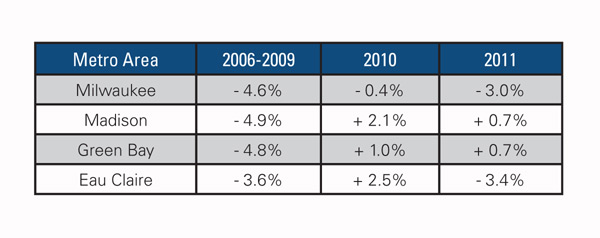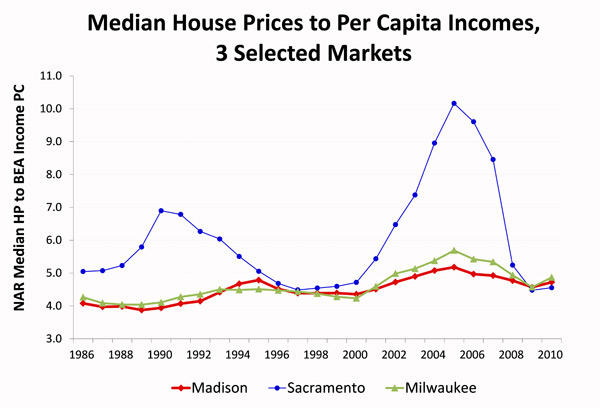Readers of a certain age will know this title from one of the most enduring quotes from baseball great, philosopher and lifelong learner, Lawrence Peter (“Yogi”) Berra.
For the past few years, I’ve shared some of my views about the state of Wisconsin’s housing market as well as the nation’s with readers of Wisconsin Real Estate Magazine. My main points in recent Januarys can be summarized as follows:
- Circa 2005 to 2006, both Wisconsin and national housing prices fell out of line with economic fundamentals, such as incomes, rents and interest rates. This trend appeared less in major Wisconsin markets than in much of the rest of the country.
- Despite our relative stability in Wisconsin, we weren’t immune from some correction, nor were we immune from the recession and the slow-growth economy that gripped most of the country.
- By last year, housing prices were largely back in sync with fundamentals. As long as buyers were looking to hold rather than flip for short-term profits, they could return to the market with some confidence due to low rates and reasonable prices, despite the potential for additional price weakness.
Well, a year later, we’re following Yogi’s dictum. House prices are still largely back in line with fundamentals. And though we have seen some additional price weakness, buyers looking to hold rather than flip for short-term profits have taken advantage of those low rates and reasonable prices. And these factors together aren’t a bad summary of the outlook for this coming year. In other words, we’re seeing “déjà vu all over again.”
“You can observe a lot by watching,” said Yogi.
And like most of Wisconsin Real Estate’s readers, I keep a close eye on housing price data. Figure 1 shows the WRA’s median house prices for selected metro areas and counties. The quarterly data are not seasonally adjusted but are adjusted to 2011 dollars, as Professor Berra recommends when he notes, “A nickel ain’t worth a dime anymore.” The gray area indicates the time in which the First-Time Homebuyer Credit was in operation from the first quarter of 2008 to the third quarter of 2010.

Nationwide, between 2006 and 2009, the National Association of REALTORS®’ median house price fell 8.2 percent, adjusted for background inflation. At that time, prices stabilized, relatively speaking, falling by about half a percent in 2010 and again in 2011. In Wisconsin, though experience in some individual markets varied, the decline between 2006 and 2009 was a little softer at roughly 5 percent. The 2010 Wisconsin decline was about the same as the national at 0.5 percent, while last year’s decline was a little steeper than the national at 1.5 percent for Wisconsin as a whole.
This same qualitative picture was found in most of our major markets:
- Substantial decline from 2006 to 2009, albeit at rates below the national average.
- Relative stability in 2010.
- And a bit more decline, or a smaller increase, in 2011.
Let’s look specifically at a few Wisconsin markets with this pattern.

“In theory there is no difference between theory and practice. In practice there is.”
In theory, the First-Time Homebuyer Credit was supposed to stabilize the housing market, but in practice, prices at first appeared to fall faster - possibly because transactions were held back in the early days to await the credit. Because many sales were moved to take advantage of the credit, the first to second quarters following the end of the credit saw another sharp decline. In the end, proving exactly how much impact the credit had on the market would be tough. The one positive impact I can confidently predict is that the credit will provide fodder for dozens of Ph.D. dissertations and research papers over the next few years as we try to determine whether it did matter.
“When you come to a fork in the road, take it.”
Compared to some markets - especially the “sand states” of California, Arizona and Nevada - we borrowed and lent more conservatively. Wisconsin’s land use and development regulation, while not without problems, has been less extreme than some coastal markets, especially California. And our demand pressure from income and population growth has been solid rather than overheated.
Most of the statistics regarding defaults and foreclosures put Wisconsin well below national averages. For example, according to our colleagues at the Mortgage Bankers Association, in the first quarter of 2011, about 1.6 foreclosures were started per hundred mortgages outstanding in Wisconsin, compared to 1.7 for the U.S. as a whole, 4.2 in California, 4.9 in Arizona and 10.3 - yikes! - in Nevada. So while we might be less than thrilled with the past year, homeowners in those sand states would view a one or two percent real decline in house prices as a real turnaround in their markets.
Figure 2 gives one rough-and-ready look at these regional differences with the comparison of Wisconsin’s two largest markets, Madison and Milwaukee, to California’s Capitol. To crudely control for income differences, we divide each annual median house price by the Bureau of Economic Analysis’ (BEA) per capita income for each metro area, year by year.

By this rough comparison, Wisconsin’s boom in the early 2000s as well as the subsequent bust were and are quite modest. But as I’ve argued before and still maintain: we should not be complacent because Sacramento and the markets it represents is our problem too. We may have been spared the worst of the housing excesses of the previous decade, but we’ve been hurt by the national recession that transmitted the pain from California and Nevada to the rest of the country and indeed the world.
Still statewide, our income drop has been lower than average. Wisconsin’s real per capita income fell 0.2 percent from 2007 to 2010, according to the BEA; national real per capita income fell 1.2 percent during that period. California fell over 4 percent and Nevada 12 percent! But if you’re in a market that took above-average hits to employment and/or income, such as Janesville or Racine, or you’re in the construction industry, your recent experience was probably not so sanguine.
“You have to give 100 percent in the first half of the game. If that isn’t enough, in the second half, you have to give what is left.”
Yogi must be disappointed with our inability to grapple effectively with some of the challenges presented to us on both the policy and political fronts. As we’ve argued repeatedly from the Graaskamp Center, effective remedies to handle distressed sales and the foreclosure overhang are needed to help right the housing market and the overall macro economy in the short run. See wisconsinviewpoint.blogspot.com/search/label/WI-FUR. And in the long run, we have to do a better job tackling our fiscal problems on both the spending and tax side. Read more at wisconsinviewpoint.blogspot.com/search/label/economic%20crisis. So far on both sides of the aisle, we’ve seen one strikeout after another and a lot of dropped fly balls by both the administration and Congress.
What will next year see?
“I wish I had an answer to that because I’m tired of answering that question,” says Yogi.
Well, I’m not so tired, though my answer is much like last year’s. In the end, we’re back to prices at or near fundamentals; employment is growing, albeit slowly; the biggest short-run risk is still the foreclosure overhang; and another year has passed without effective action. I see another year of flat-to-modest growth in housing prices, with some downside risk if a big chunk of the foreclosure glut hits the market, though this will be less of a problem here than in the sand states. If we did see further declines, these would, in the main, be temporary overshooting until we work through the foreclosures and other distressed sales. If we can keep economic growth positive and slowly bring down the rate of unemployment, that will be another big plus for our industry, to say nothing of a huge plus to the firms and workers concerned! Potential homebuyers who will be in place for five years or more and can qualify for a conservative mortgage at today’s low rates will find it a good time to buy. But we should end every economic outlook discussion with another lesson from Professor Berra: “It’s tough to make predictions, especially about the future.”
Stephen Malpezzi is Lorin and Marjorie Tiefenthaler Professor in the James A. Graaskamp Center for Real Estate at the Wisconsin School of Business.


